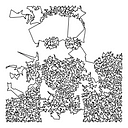



Tell us a little about your background
I play with data and code. I teach Data Science in Italy since 2002 and experiment with code as a generative artist since 2012. I love mining information from data and minting the outcome of my code.
How did you learn about Art Blocks?
I met Erick Calderon during a hot summer in 2018. He told me about his idea of creating a place to explore creativity with generative design and I coded one of the first pilot projects for AB — HashCoil. But the times were not mature for the idea of digital art as a performance. Erick’s idea did not immediately take off (but later it skyrocketed!) and I recycled the work with another name — Coilgram — which is now one of my most popular series.
Tell us a little about your project
InC is a tribute to the musical piece “In C” composed by Terry Riley in 1964. It is a random walk through the canvas. Short design fragments emerge from this promenade, composed for an indefinite number of performers/collectors, much like the original composition by Terry Riley. The sketch is in fact interactive, but I’ll not disclosure the interaction keys ;-)
Was there someone or something that inspired you when the idea came up to create your project?
Yes. The artworks of Giorgia Fincato, an Italian traditional painter. When I met her, I asked if she were a generative artist, hoping I had found a new generative fellow. She answered surprised: “What is generative art?”. I later discovered that Giorgia makes all her artworks with paper and pen, following only her mysterious intuition, during a sort of meditation in which she never blinks. I challenged her saying I could make a program that paints in the same way. I spent quite some time trying to code her style this last summer. The outcome was impressive (I recall Giorgia was initially shocked). Then I tuned the code to move away from her style: InC was born!
What was your approach for creating this project? Do you have a good idea of what it will look like at first or do you tinker around with some small ideas and let it evolve over time?
As I said I was inspired by Giorgia’s work. This produced the first version of InC. Then I almost completely changed the code, moving far away from her style — for instance, I introduced colors. I then noticed that Giorgia’s new works are colorful! So, it was a kind of chase between the two of us.
Can you talk to us about your approach for selecting your color palettes?
Not very sophisticated. Each artwork uses two colors. The first one is chosen randomly by the machine. The second is its complementary color in RGB scheme. In fact, I loop in the code to avoid pairs of colors that are too close.
Were there any ‘bugs’ in your code that you found out about and decided to leave in for this project?
Well, the color loop described above. In principle, it’s an infinite loop: if the second color is always too close to the first, it never ends! However, the probability of this event is quite low. At least I hope. Let’s see next Tuesday ;-)
Mental health is so important in the fast-paced NFT/crypto space. How do you wind down after coding a project?
Boxe, Gyrokinesis, and Odaka Yoga. Every week.
Do you have any words of advice for generative artists who are just starting to code their own project?
Yes. Study the early generative artists of 50s and 60s of the previous century. Like Georg Nees and Vera Molnar. Try to re-code their early pieces. These are small exercises that will teach you all about generative art. Everything is hidden in these genesis blocks.
Do you have any other NFTs available outside of Art Blocks? If so, where?
SuperRare, KnownOrigin, AsyncArt, MakersPlace, Foundation, Hic et Nunc… Climb my link tree.
